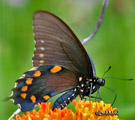Native Plants
Search for native plants by scientific name, common name or family. If you are not sure what you are looking for, try the Combination Search or our Recommended Species lists.
Aristolochia macrophylla
Aristolochia macrophylla Lam.
Pipevine, Dutchman's Pipe
Aristolochiaceae (Birthwort Family)
Synonym(s): Aristolochia durior, Isotrema macrophyllum
USDA Symbol: ARMA7
USDA Native Status: L48 (N), CAN (I)
Pipevine or Dutchman’s pipe is a picturesque, deciduous vine, climbing 20-35 ft. by means of twining stems. Fast-growing, green stems bear large (12 in.), heart-shaped leaves, dark-green above and pale-gray beneath. Flower occur singly or 2-3 per cluster and are pipe-shaped, mottled green and burgundy, with yellow tubes. Cylindrical, cucumber-like capsules, 3-4 in. long, stay green most of the summer eventually ripening to gray or black.
A characteristic plant of the southern Appalachian hardwood forests, Dutchman's Pipe is often cultivated outside its native range. Flowers of this genus were once used as an aid in childbirth, since they were thought to resemble a human fetus. The similar Woolly Dutchman's-Pipe (A. tomentosa) has a bractless flower stalk, a yellowish calyx that is purple around the opening, and downy and whitish leaf undersurfaces.
Plant Characteristics
Duration: PerennialHabit: Vine
Root Type: Tap
Leaf Retention: Deciduous
Leaf Arrangement: Alternate
Leaf Complexity: Simple
Leaf Shape: Reniform
Leaf Venation: Palmate
Leaf Pubescence: Puberulent
Leaf Margin: Entire
Leaf Apex: Obtuse
Leaf Base: Cordate
Breeding System: Flowers Bisexual
Fruit Type: Capsule
Size Notes: Climber, stems up to about 35 feet long.
Leaf: Green above
Autumn Foliage: yes
Fruit: Green, Brown 4-10 cm
Bloom Information
Bloom Color: Green , Purple , BrownBloom Time: May , Jun
Distribution
USA: AL , CT , GA , KY , MA , MD , MI , NC , NJ , NY , PA , SC , TN , VA , VT , WVNative Distribution: S.w. PA, s. in the uplands to GA & AL; naturalized north and eastward
Native Habitat: Rich woods; stream banks
Growing Conditions
Water Use: MediumLight Requirement: Part Shade
Soil Moisture: Moist
Soil Description: Organic, well-drained soils.
Conditions Comments: If a screen is desired, plant 1-2 ft. apart and provide support. Pinch growing tips to encourage branching. Prune as needed when dormant. Disease and insect free.
Benefit
Attracts: ButterfliesLarval Host: Pipevine swallowtail.
Butterflies and Moths of North America (BAMONA)
|
Pipevine Swallowtail (Battus philenor)  Larval Host |
Propagation
Description: Increase by layering, division, July cuttings, or by seed sown outdoor in fall.Seed Treatment: If seeds are not sown in fall, they should be stratified for 3 months at 40 degrees.
Commercially Avail: yes
From the National Organizations Directory
According to the species list provided by Affiliate Organizations, this plant is on display at the following locations:Delaware Nature Society - Hockessin, DE
Natural Biodiversity - Johnstown, PA
Mt. Cuba Center - Hockessin, DE
Additional resources
USDA: Find Aristolochia macrophylla in USDA PlantsFNA: Find Aristolochia macrophylla in the Flora of North America (if available)
Google: Search Google for Aristolochia macrophylla
Metadata
Record Modified: 2016-08-04Research By: TWC Staff